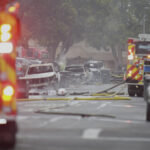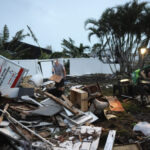Officials were investigating what caused a navigational system that helps guides planes onto arriving runways to fail, stranding thousands of passengers on hundreds of flights at Los Angeles International Airport and other airports across the country.
Many flights had to be delayed by 90 minutes or more and other flights were canceled before the equipment was fixed early Monday afternoon, Federal Aviation Administration officials said. Some flights originating at airports nationwide were initially ordered to remain on the ground, then told to delay takeoff for about 90 minutes, FAA spokesman Mike Fergus said.
By late Monday, the ground delay program had ended and general departure delays and arrivals were 15 minutes or less, said airport spokesman Tom Winfrey.
It was the second serious problem in three weeks to disable part of LAX. Sen. Barbara Boxer, D-Calif., wrote to FAA Administrator Marion C. Blakey to demand an investigation into the landing system’s failure.
“This is the second serious aviation problem we have had in Southern California. You need to pay attention to ensure that all of the systems — whether it is backup generators or ILS — are in good working order,” Boxer wrote.
Monday’s malfunction at the world’s fifth-busiest passenger airport started at 8:46 a.m. PDT, when equipment used to guide planes onto one incoming runway failed, Fergus said.
The problem was compounded by the fact that one of the airport’s four runways was closed for a major construction project last week. To compensate, one of the departure runways was handling both departures and landings — and it was that shared runway that had the problem.
The number of landings, usually about one a minute, was reduced to 32 an hour, Fergus said.
By 10:45 a.m., controllers changed the landing configuration and reversed the direction of all flights, so the damaged equipment was not needed, Fergus said. Shortly after noon, technicians had fixed the computerized landing system and the direction of all flights was returned to normal, he said.
Laney Fishera, 46, from Topsfield, Mass., said her flight from Boston circled above the ocean for about 30 minutes before landing in Los Angeles.
“We had to fly over the ocean, which was really weird,” she said. “They said they wanted us to circle around for a while until a runway space opened for us.”
Marilyn Ushman, 63, from Palm Desert, was trying to fly to Palm Springs, but learned that her flight had been canceled because of too much air traffic.
“Now they’ve got us booked on a 7:45 p.m. flight, which is just absolutely ridiculous. We’re going to try and rent a car, and then try and fight with the airlines and try and get (money for) this leg back,” said Ushman, who was returning from a vacation in Montreal.
The broken piece of equipment, called a “localizer,” acts as a beacon to guide planes onto arriving runways using an instrument landing system. Fergus compared it to a signal at the end of a very long driveway. It is most crucial when it’s foggy or hazy and it was foggy at the airport Monday.
Air traffic controllers said the localizer flickered off intermittently Saturday, but that each time it came back up after a few minutes. Technicians found nothing wrong with the beacon after the outages, said Diane Aceves, an air traffic controller and local president of the National Air Traffic Controllers Association.
FAA spokesman Ian Gregor said it took more than three hours to fix the system Monday because the technician, who works at several airports in the region, was not at LAX at the time.
Aceves said the malfunction prompted workers in the control tower to scramble to divert planes as they were about to land.
“We had one runway missing already,” Aceves said. “It definitely caused a lot of extra work for controllers and pilots, especially the radar controllers who were stringing the arrivals out. There are no lull periods.”
The airport’s $333 million runway relocation and taxiway project is designed to prepare LAX for the next generation of Airbus 380 jumbo jets and reduce the risk of runway accidents, airport officials said last week.
The announced closure will add a 6-minute delay to all incoming flights in the next eight months.
On July 18, LAX experienced a major power failure that backed up flights across parts of the western United States and Canada and shut down all telephone, electrical and radar functions.
That outage was caused when a vehicle crashed into a power pole in Palmdale, causing a power fluctuation that prompted the air traffic control center’s backup generator to turn on. About an hour later, that generator failed.
Outside aviation experts said that the equipment failures raise questions about the nation’s aviation system, which is straining under passenger loads that have rebounded to their highest levels since Sept. 11, 2001.
LAX, for example, averages 1,800 daily flights and will serve an estimated 18.7 million passengers this summer, 200,000 more than last year.
“The FAA’s complete instrument system, as we know, is somewhat accident prone. We need to do more what-if thinking,” said Jack Keady, an aviation consultant who has followed the problems at LAX.
Was this article valuable?
Here are more articles you may enjoy.

 Two Chevron Workers Die of Injuries From Angola Platform Fire
Two Chevron Workers Die of Injuries From Angola Platform Fire  Citi Reverses Course on Firing of Japan Trader Five Years On
Citi Reverses Course on Firing of Japan Trader Five Years On  Plane Crashes into San Diego Neighborhood, Setting Homes And Vehicles on Fire
Plane Crashes into San Diego Neighborhood, Setting Homes And Vehicles on Fire  Here Comes Another Busy Atlantic Hurricane Season, But Will It Be as Crazy as 2024?
Here Comes Another Busy Atlantic Hurricane Season, But Will It Be as Crazy as 2024? 